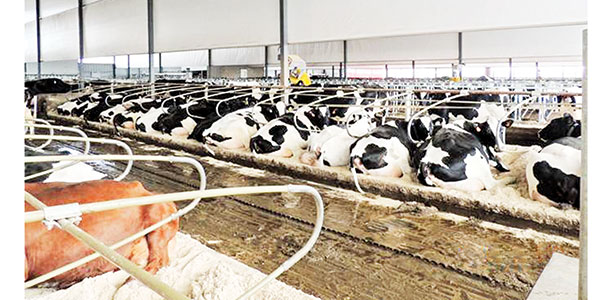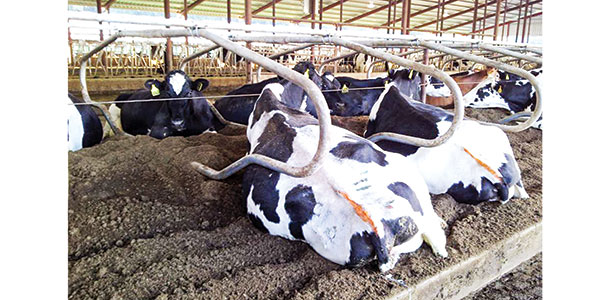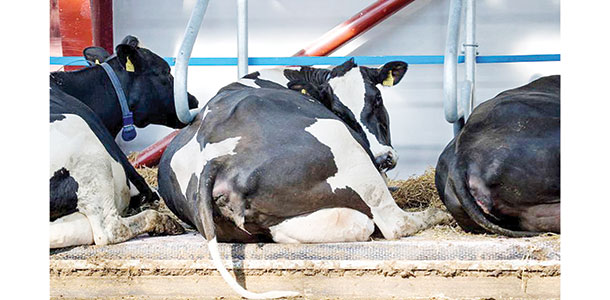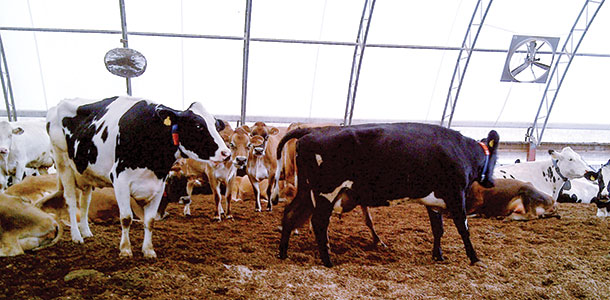Robotic milking embraces the basics in herd management and milk production, but other essential components like lifestyle, daily routines and housing facilities can and do vary. One hot topic concerning housing facilities in automatic milking system barns is bedding. Appropriate bedding systems should fulfill the requirements of lactating dairy cows milked robotically in a sustainable way, considering these four pillars:
• Animal welfare
• Farm profitability
• Social responsibility
• Environment
In 2013, the University of Minnesota surveyed bedding systems of 52 robotic dairies in the Midwest. They found 42 percent were using mattresses, 27 percent sand, 13 percent waterbeds, 6 percent bedded packs and 12 percent others.
Let’s examine some of these bedding systems against the following variables:
• Cow comfort: In terms of cushion, traction and support, with effects on overall performance but mainly cow flow and access to robots.
• Locomotion: Lame cows won’t voluntarily visit the robot station. Healthy cows drive robot efficiency.
• Milk quality and udder health: The only way to ensure a profitable herd and a quality product.
• Impact on equipment: Wear and maintenance costs are important variables to evaluate for economic and planning purposes.
• Cow flow: The goal is to maximize voluntary access to the robots and improve cow behavior.
• Total costs: A critical variable in any business.
• Environment: Automatic milking system operations must be in compliance with local regulations.
Three categories of bedding systems are the following:
1. Deep bedding
• Sand is considered the gold standard in terms of cow comfort, locomotion, and milk quality and udder health – both in conventional or robotic operations.
A survey performed by the University of Wisconsin of 176 herds found a 7-pound increase in milk per cow per day when compared to herds with mattresses. Also, sand-bedded herds had lower somatic cell counts (SCC), lower prevalence of lameness, lower turnover rates and improved fresh cow health.
A University of Minnesota survey showed that sand-bedded automatic milking system dairies in the Midwest had a lameness prevalence (percent locomotion score more than 3) of 22.5 percent, comparable only to compost-bedded packs or pasture. Severe hock lesion prevalence was only at 3.8 percent.
DeLaval surveyed udder health records and found sand-bedded facilities have a bulk tank SCC of 40,000 to 150,000.

Pay special attention to
• Wear on equipment, as it will affect maintenance and running costs. Normally sand increases robot maintenance costs between 50 percent and 80 percent.
Recommendations
• Ask your milking machine provider for the best robot configuration to deal with sand. Also ask about the maintenance and running costs so you can calculate the return on investment (ROI). Sand is all about ROI.
• Straw, sawdust, kiln-dried shavings and other organic materials have similar effects in terms of cow comfort, locomotion and cow flow with slight differences, especially when compared with sand.
This kind of organic bedding also has major advantages in terms of impact on equipment and manure handling.
Pay special attention to
• Cow cleanliness is a real concern when using organic bedding. High bacteria growth is a problem due to the fast proliferation of pathogens that affect the mammary gland.
• To properly maintain these stalls, labor and bedding expenses can become a big concern as well as potential cow flow disruptions.
Recommendations
• Detailed and specific standard operating procedures (SOPs) are needed in order to ensure proper management.
• Ensure consistent hair removal from the udders; otherwise, clinging organic manure will affect robot performance.
• Recycled manure solids deliver clear advantages in terms of cow comfort, locomotion, cow flow, total cost and impact on equipment, in addition to availability and management.
There are three popular ways to produce recycled manure solids:
• Anaerobic digested manure
• Separation of raw manure
• Mechanical drum composting
Recycled manure solids can be used on top of mattresses with a 2-inch to 4-inch layer or as deep as 8 to 12 inches of material. With a top layer there is some difficulty in keeping it in place, and with deep beds there is a greater risk of increased coliform counts.
A survey conducted by the University of Minnesota in 2012 found out of 38 farms using these kinds of systems, 50 percent used deep bedding, 39 percent on top of mattresses and 11 percent in mixed configurations.

Pay special attention to
• Udder health can be compromised, representing a potential risk for coliform outbreaks, especially caused by Klebsiella. The probability increases when raw manure solids and hot humid climates collide. Bulk tank SCC is comparable to other kinds of systems.
Recommendations
• Ask your milking system provider for previous experiences with recycled manure solids and what kind of settings and milking procedures they’ve used to help prevent an environmental risk.
• A well-designed vaccination program for coliform mastitis is required.
• Monitor dry matter and temperature on a daily basis.
• Detailed and specific SOPs are needed in order to ensure proper management.
2. Mattresses
Mattresses are the most popular bedding system in robotic milking operations around the world.
Their performance depends on proper management, mattress quality and the amount of organic bedding on top. This last point applies without exceptions. Great managers with correct strategies have achieved good levels of cow comfort, locomotion, milk quality and udder health, low impact on equipment and low cow flow disruption, with very good options for bedding automation, driving to very successful operations worldwide.

Pay special attention to
• Cow comfort and locomotion can be a concern. Due to mattresses’ limitations on traction, cushion and support, cows could spend more time standing in stalls with shorter lying bout times, driving higher congestion levels in the alleys. If a proper strategy isn’t employed, this can have a negative impact on cow flow, milkings per day, and of course, milk production.
• Udder health – Dairies in the U.S. were surveyed and facilities using mattresses with organic bedding on top had bulk tank SCC of 150,000 to 300,000.
Recommendations
• Choose the best option on the market in terms of cushion, traction and support.
• Always add organic bedding on top in order to balance cow comfort and facilitate surface cleanliness. Adding 1 to 4 inches of organic bedding on top will optimize cow comfort and udder health.
• Detailed and specific SOPs are needed in order to ensure proper management.
3. Compost-bedded pack
Compost-bedded packs offer clear benefits in terms of cow comfort, locomotion, low impact on equipment and low initial cost of investment.
It also provides ideal conditions for reproductive performance as it facilitates heat signs and overall cow health. A study performed by the University of Kentucky showed how calving intervals decreased from 14.3 to 13.7 months when comparing the year before to the second year after the system was implemented.
Depending on the style of compost-bedded pack, the cost could be significant or almost non-existent; it will depend on local conditions and design.

Pay special attention to
• Milk quality and udder health can be compromised, as the prevalence of dirty cows is normally the highest compared to other bedding systems. Again, as with any other organic bedding, it is very sensitive to management capabilities. Normally, robotic milking farms with well-managed compost-bedded packs have a bulk tank SCC of 200,000 to 400,000. Of course, there are some exceptional farms with very good bulk tank SCC.
• Depending on local conditions, bedding cost can be a big concern. Some robotic-milking dairies in the Midwest have switched to other kinds of bedding due to extremely high costs.
Recommendations
• Cow hygiene is a reflection of the compost itself; the art of using a compost-bedded pack is to know how to produce compost. It is crucial to monitor variables such as temperature, humidity and area per cow.
• Avoid green or wet shavings, as Klebsiella levels can increase dramatically, and therefore the risk of coliform mastitis can be high.
• A well-designed vaccination program for coliform mastitis is required.
• Detailed and specific SOPs are needed in order to ensure proper management.
• Ask your milking system provider for previous experiences with compost-bedded packs. Also ask about the settings and milking procedures they’ve used to help prevent environmental risks.
• Define a barn layout that facilitates handling of cows and fetching routines.Keep it simple and manageable
Simplicity is the ultimate sophistication. This is all about you making the best decision for your own dairy, with the cows being top priority and the sustainability of your automatic milking system operation in the horizon. PD
Francisco Rodriguez is a veterinarian and works for DeLaval as an adviser for automated milking systems in North America.
References omitted due to space but are available upon request. Click here to email an editor.
Francisco Rodriguez
Dairy Management Adviser
DeLaval Inc.





